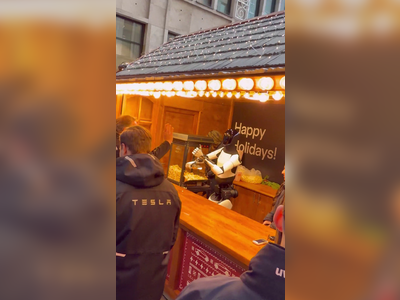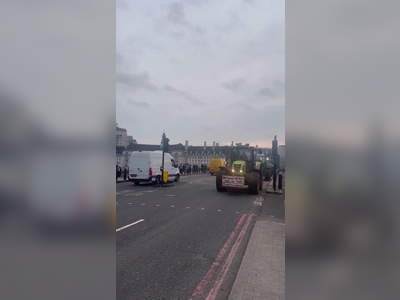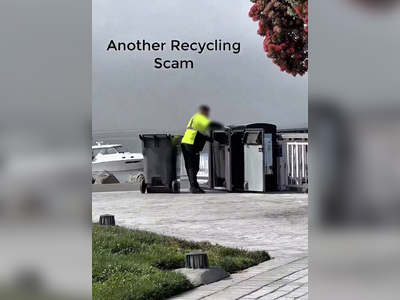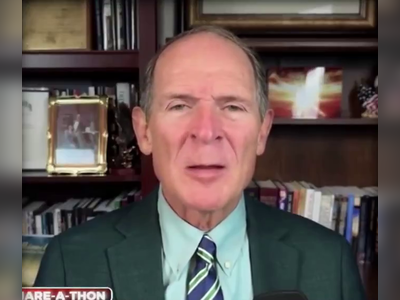
The Cartel has taken over TikTok...
Guns, Drugs and Viral Content: Welcome to Cartel TikTok. Mexico is set to shatter another murder record, but that grim reality is nowhere to be seen on the TikTok videos that go viral by showcasing drug cartel culture.
Tiger cubs and semiautomatic weapons. Piles of cash and armored cars. Fields of poppies watered to the sound of ballads glorifying Mexican drug cartel culture.
This is the world of Cartel TikTok, a genre of videos depicting drug trafficking groups and their activities that is racking up hundreds of thousands of views on the popular social media platform.
But behind the narco bling and dancing gang members lies an ominous reality: With Mexico set to again shatter murder records this year, experts on organized crime say Cartel TikTok is just the latest propaganda campaign designed to mask the blood bath and use the promise of infinite wealth to attract expendable young recruits.
“It’s narco-marketing,” said Alejandra León Olvera, an anthropologist at Spain’s University of Murcia who studies the presence of Mexican organized crime groups on social media. The cartels “use these kinds of platforms for publicity, but of course it’s hedonistic publicity.”
Circulating on Mexican social media for years, cartel content began flooding TikTok feeds in the United States this month after a clip of a high-speed boat chase went viral on the video-sharing platform.
American teens were served the boat chase video on their For You page, which recommends engaging videos to users. Millions liked and shared the clip. Their clicks boosted the video in the For You page algorithm, which meant more people viewed it.
And once they viewed the boat chase video, the algorithm began to offer them a trickle, then a flood of clips that appeared to come from drug trafficking groups in Mexico.
“As soon as I started liking that boat video, then there’s videos of exotic pets, videos of cars,” said Ricardo Angeles, 18, a California TikToker interested in cartel culture.
“It’s fascinating,” he said, “kind of like watching a movie.”
Others began noticing the surge of cartel videos as well, and posting reactions to the deluge of guns and luxury cars filling their feeds.
“Did the cartels just roll out their TikTok marketing strategy?” asked one flummoxed user in a video viewed some 490,000 times. “Is the coronavirus affecting y’all’s sales?”
Asked about their policy regarding the videos, a TikTok spokeswoman said that the company was “committed to working with law enforcement to combat organized criminal activity,” and that it removed “content and accounts that promote illegal activity.” Examples of cartel videos that were sent to TikTok for comment were soon removed from the platform.
While cartel content might be new for most teen TikTokers, according to Ioan Grillo, author of “El Narco: Inside Mexico’s Criminal Insurgency,” online portrayals of narco culture go back more than a decade, when Mexico began ramping up its bloody war against the cartels.
At first, the videos were crude and violent — images of beheadings and torture that were posted on YouTube, designed to strike fear in rival gangs and show government forces the ruthlessness they were up against.
But as social platforms evolved and cartels became more digitally savvy, the content became more sophisticated.
In July, a video that circulated widely on social media showed members of the brutal Jalisco New Generation Cartel in fatigues, holding high-caliber weapons and cheering their leader next to dozens of armored cars branded with the cartel’s Spanish initials, C.J.N.G.
The show of force appeared online at the same time President Andrés Manuel López Obrador was visiting the states that make up the cartel’s stronghold.
“That is kind of a kick, a punch in the stomach to the government’s security strategy,” Mr. Grillo said.
Mr. López Obrador, who campaigned on a promise of confronting crime with “hugs not bullets,” has so far been unable to make a significant dent in the country’s soaring violence, with a record 34,582 murders registered last year alone.
But while some videos are still made to strike terror, others are created to show young men in rural Mexico the potential benefits of joining the drug trade: endless cash, expensive cars, beautiful women, exotic pets.
“It’s all about the dream, it’s all about the hustle,” said Ed Calderon, a security consultant and former member of Mexican law enforcement. “That’s what they sell.”
According to Falko Ernst, senior Mexico analyst for the International Crisis Group, a global think tank, some of the TikTok videos may be produced by cartel members themselves, especially young hit men or “sicarios” keen to show off the spoils of war.
Still, he said, most are probably filmed by young, lower-level operators in the gangs, then shared widely on the web by their friends or those longing for the lifestyle.
But whether they are made and shared by cartels or simply produced by aspiring gangsters, the ultimate goal is the same: drawing in an army of young men willing to give their lives for a chance at glory.
The gangs, Mr. Ernst said, depend on this “sea of youngsters.”
And while videos of bejeweled guns and decked-out cars have been circulating on Instagram and Facebook for years, TikTok has brought a new dimension to the cartel genre.
“The message has to be quick, it has to be engaging, and it has to be viral,” said Ms. León, the anthropologist. “Violence becomes fun, or even put to music.”
One video, which attracted more than 500,000 likes before it was removed, shows a farmer slicing unripe seed pods in a field of poppies, presumably to harvest the resin for heroin production.
“Here in the mountains, there are only hard workers,” says a voice-over. “Just good people.”
In another video, from a now-disabled account called “The clown of the CJNG,” in reference to the Jalisco cartel, a figure dressed in black with a bulletproof vest and an AR-15 rifle does a dance move known as the Floss.
Such videos may be intended for a Mexican audience, but for users in the United States who help promote them, they tap into an increasingly popular fascination with the cartel world, one propagated by shows like “Narcos” on Netflix.
That was in part the allure for Mr. Angeles, the California teenager, whose parents emigrated from Mexico before he was born.
Even as he acknowledged the real-world violence behind the videos, Cartel TikTok has become a way of connecting with Mexican popular culture from a safe distance.
“There’s a difference between watching ‘Narcos’ and getting kidnapped by one,” Mr. Angeles said.
The videos also provide a stark reminder of what life may have looked like had his parents not sought better opportunities north of the border.
“I could’ve been in that lifestyle,” Mr. Angeles said. But “I would much rather be broke and nameless than rich and famous.”
This is the world of Cartel TikTok, a genre of videos depicting drug trafficking groups and their activities that is racking up hundreds of thousands of views on the popular social media platform.
But behind the narco bling and dancing gang members lies an ominous reality: With Mexico set to again shatter murder records this year, experts on organized crime say Cartel TikTok is just the latest propaganda campaign designed to mask the blood bath and use the promise of infinite wealth to attract expendable young recruits.
“It’s narco-marketing,” said Alejandra León Olvera, an anthropologist at Spain’s University of Murcia who studies the presence of Mexican organized crime groups on social media. The cartels “use these kinds of platforms for publicity, but of course it’s hedonistic publicity.”
Circulating on Mexican social media for years, cartel content began flooding TikTok feeds in the United States this month after a clip of a high-speed boat chase went viral on the video-sharing platform.
American teens were served the boat chase video on their For You page, which recommends engaging videos to users. Millions liked and shared the clip. Their clicks boosted the video in the For You page algorithm, which meant more people viewed it.
And once they viewed the boat chase video, the algorithm began to offer them a trickle, then a flood of clips that appeared to come from drug trafficking groups in Mexico.
“As soon as I started liking that boat video, then there’s videos of exotic pets, videos of cars,” said Ricardo Angeles, 18, a California TikToker interested in cartel culture.
“It’s fascinating,” he said, “kind of like watching a movie.”
Others began noticing the surge of cartel videos as well, and posting reactions to the deluge of guns and luxury cars filling their feeds.
“Did the cartels just roll out their TikTok marketing strategy?” asked one flummoxed user in a video viewed some 490,000 times. “Is the coronavirus affecting y’all’s sales?”
Asked about their policy regarding the videos, a TikTok spokeswoman said that the company was “committed to working with law enforcement to combat organized criminal activity,” and that it removed “content and accounts that promote illegal activity.” Examples of cartel videos that were sent to TikTok for comment were soon removed from the platform.
While cartel content might be new for most teen TikTokers, according to Ioan Grillo, author of “El Narco: Inside Mexico’s Criminal Insurgency,” online portrayals of narco culture go back more than a decade, when Mexico began ramping up its bloody war against the cartels.
At first, the videos were crude and violent — images of beheadings and torture that were posted on YouTube, designed to strike fear in rival gangs and show government forces the ruthlessness they were up against.
But as social platforms evolved and cartels became more digitally savvy, the content became more sophisticated.
In July, a video that circulated widely on social media showed members of the brutal Jalisco New Generation Cartel in fatigues, holding high-caliber weapons and cheering their leader next to dozens of armored cars branded with the cartel’s Spanish initials, C.J.N.G.
The show of force appeared online at the same time President Andrés Manuel López Obrador was visiting the states that make up the cartel’s stronghold.
“That is kind of a kick, a punch in the stomach to the government’s security strategy,” Mr. Grillo said.
Mr. López Obrador, who campaigned on a promise of confronting crime with “hugs not bullets,” has so far been unable to make a significant dent in the country’s soaring violence, with a record 34,582 murders registered last year alone.
But while some videos are still made to strike terror, others are created to show young men in rural Mexico the potential benefits of joining the drug trade: endless cash, expensive cars, beautiful women, exotic pets.
“It’s all about the dream, it’s all about the hustle,” said Ed Calderon, a security consultant and former member of Mexican law enforcement. “That’s what they sell.”
According to Falko Ernst, senior Mexico analyst for the International Crisis Group, a global think tank, some of the TikTok videos may be produced by cartel members themselves, especially young hit men or “sicarios” keen to show off the spoils of war.
Still, he said, most are probably filmed by young, lower-level operators in the gangs, then shared widely on the web by their friends or those longing for the lifestyle.
But whether they are made and shared by cartels or simply produced by aspiring gangsters, the ultimate goal is the same: drawing in an army of young men willing to give their lives for a chance at glory.
The gangs, Mr. Ernst said, depend on this “sea of youngsters.”
And while videos of bejeweled guns and decked-out cars have been circulating on Instagram and Facebook for years, TikTok has brought a new dimension to the cartel genre.
“The message has to be quick, it has to be engaging, and it has to be viral,” said Ms. León, the anthropologist. “Violence becomes fun, or even put to music.”
One video, which attracted more than 500,000 likes before it was removed, shows a farmer slicing unripe seed pods in a field of poppies, presumably to harvest the resin for heroin production.
“Here in the mountains, there are only hard workers,” says a voice-over. “Just good people.”
In another video, from a now-disabled account called “The clown of the CJNG,” in reference to the Jalisco cartel, a figure dressed in black with a bulletproof vest and an AR-15 rifle does a dance move known as the Floss.
Such videos may be intended for a Mexican audience, but for users in the United States who help promote them, they tap into an increasingly popular fascination with the cartel world, one propagated by shows like “Narcos” on Netflix.
That was in part the allure for Mr. Angeles, the California teenager, whose parents emigrated from Mexico before he was born.
Even as he acknowledged the real-world violence behind the videos, Cartel TikTok has become a way of connecting with Mexican popular culture from a safe distance.
“There’s a difference between watching ‘Narcos’ and getting kidnapped by one,” Mr. Angeles said.
The videos also provide a stark reminder of what life may have looked like had his parents not sought better opportunities north of the border.
“I could’ve been in that lifestyle,” Mr. Angeles said. But “I would much rather be broke and nameless than rich and famous.”
AI Disclaimer: An advanced artificial intelligence (AI) system generated the content of this page on its own. This innovative technology conducts extensive research from a variety of reliable sources, performs rigorous fact-checking and verification, cleans up and balances biased or manipulated content, and presents a minimal factual summary that is just enough yet essential for you to function as an informed and educated citizen. Please keep in mind, however, that this system is an evolving technology, and as a result, the article may contain accidental inaccuracies or errors. We urge you to help us improve our site by reporting any inaccuracies you find using the "Contact Us" link at the bottom of this page. Your helpful feedback helps us improve our system and deliver more precise content. When you find an article of interest here, please look for the full and extensive coverage of this topic in traditional news sources, as they are written by professional journalists that we try to support, not replace. We appreciate your understanding and assistance.











